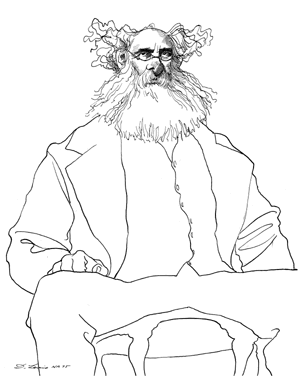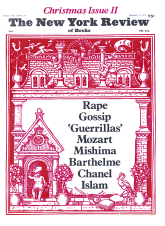Lord Snow’s book only seems larger than it is. This is because it has been blown up, with dozens and dozens of black-and-white illustrations and many very handsome plates in rich color. Some of these are closely connected with Trollope, being period illustrations from his novels, or paintings of Trollope himself and drawings of the houses he lived in and the places where he worked for the post office. But most of them are simply Victorian period studies—some, very delightful ones—which can only be tied up to Trollope by the adroit use of captions: one of these tells us, for instance, that though the engraving above is not of a house in which Trollope lived, it looks very much like a house in which Trollope did live. And so on. The reader will get some amusement out of these captions, though of course, as is always the way with such handsome Christmas books, there is no need to be a reader at all.
Lord Snow’s contribution to the Trollope “revival” announced by his publisher fits in pretty well with all the other bits and pieces. It is badly written in a self-assured manner, and very scatterbrained. Sentences start off strongly in a particular direction and then run into commas, dashes, and parentheses that divert them entirely elsewhere; only with difficulty do they rediscover the line they first thought of. Some sentences seem to have no meaning at all, or must be cross-examined two or three times before they confess to one. The prose does not suggest a written text; the blurting and the hopping and the sudden shoots sideways are those of a dictated work or a series of lectures, as are the jumpy tempo and the intermittent vagaries. A lecture, for example, might begin (as Chapter VII does) with the sentence, “Trollope must be one of the few Englishmen whose lives have been changed for the better by going to Ireland”; but nobody would write such a statement because there would be time to think of the hundreds of thousands of Englishmen who have gone to Ireland most profitably over the last one thousand odd years.
Other puzzles are more difficult to explain. What sort of writing can be described as “quiet and discomforting to read”? What is meant by “Barchester Towers has gone further and wider than any other of Trollope’s novels”? Can it be right to say that “Mrs. Trollope viewed [Anthony’s] marriage with cheerful snobbish disapproval”—what is cheerful snobbish disapproval? As for “Now he had by effort made something a bit more respect-worthy,” it is just too far below the proper standard of a respect-worthy pen-pusher.
Most of Lord Snow’s text is written in this clumsy, thoughtless way, as if pressed for both time and thought. And yet, Lord Snow still finds room to ramble and is happy simply to entertain the reader with any matter that comes into his head. There is, for example, a long dissertation (with full-page photograph) on Sir Henry Taylor, a civil servant who wrote verse dramas. It is good to learn about Sir Henry, but it is not necessary.
Lord Snow gives us the whole life, though not as Trollope gave it in the famous posthumous Autobiography, whose mercenary emphasis ensured his total extinction for a long time. Lord Snow agrees in disliking this work because, he says, it only presents Trollope’s “persona”—the rude, rough, hearty fellow behind whom the hypersensitive psychological novelist looked deep into the human heart and toyed delicately with the nerve endings. Both Trollopes, in fact, are to be found in the Autobiography, and some may think that the sensitive gent is just as pronounced as the fox-hunting capitalist. But Lord Snow holds his particular opinion because he is out to explain why Trollope was such an excellent writer (which is not explained in the Autobiography) and why a man of Tolstoy’s genius could exclaim: “Trollope kills me, kills me with his excellence.”
It is a most difficult excellence to explain. Henry James, who had gentler hands than Lord Snow has, explained it in the simplest language:
We care what happens to people only in proportion as we know what people are. Trollope’s great apprehension of the real, which was what made him so interesting, came to him through his desire to satisfy us on this point—to tell us what certain people were and what they did in consequence of being so [reviewer’s italics].
Lord Snow, who quotes this passage, holds much the same opinion. All novelists of the “realistic” school, he argues, have this “apprehension of the real”: Tolstoy is probably the greatest of them. In the opposite corner are such as Cervantes and Dostoevsky, who are not out to delineate characters exactly but to create massive and eloquent representations of human personality. One might add to these the curious example of Kafka, who delineates no character but that of the reader. It is the reader himself who struggles to reach the high castle, who is caught in the trials of human justice, who is the observer of the Great Wall that serves no purpose but that of illusion. And as the years of the century pass, this painful identification becomes increasingly apt.
Advertisement
Such could never be the case with Trollope. His characters are themselves: the reader may put himself in their place, but he can never become one with any one of them. The very base of the excellence is in the variety of the individuals, and they remain unchanged in perpetuity.
But what makes this excellent? We are always left with this dreadful question in the end—the question of what magic works the wand. Many novelists have tried to do what Trollope did—and a large and various host of interacting characters marching through many volumes has been the consequence. Only Trollope’s hand has been missing.
Lord Snow picks on what he calls “percipience” as the secret of the magic. Percipience, as he defines it, is the faculty of looking into things—people, in his case—and divining the hidden workings of the mechanisms. It includes the power to see each person not simply as he is now but as he was once and as he will be in years to come. This power is, of course, essential to the novelist whose characters must run through several volumes.
Lord Snow is attached to percipience as a recipe for magic, but it is hard not to feel that though the word is a good one it is only a substitute for our old friends perception, intuition, sympathy, understanding—and a great many more in Roget’s Thesaurus. “When we lose our grip / A Word comes in handy” said Goethe, and Lord Snow would seem to have reached for a Word.
More painful is the fact that behind something like percipience must lie still another secret. It is not enough to divine a character; one must also be able to give memorable expression to what one has divined. Trollope could do so, but how did he do it? What is the secret of his prose?
Lord Snow sees the need to tackle this one and plumps for a special quality in Trollope’s dialogue. He must then, of course, define the special quality, and since this is the most difficult of all things to do, one is not surprised when he ends up with a long talk on British speech habits instead, a subject of comparatively little interest and quite beside the point.
Trollope, then, remains at the end much as he was at the beginning, though Lord Snow has cleared up some untidy bits of his private life and given special attention to the Bostonian lady friend, Kate Field (see, in full color, The Boston Common, by Winslow Homer). It was a tough assignment, and Lord Snow’s book shows it, but as an answer to Christmas it should, as Lord Snow would say, go further and wider.
This Issue
December 11, 1975




